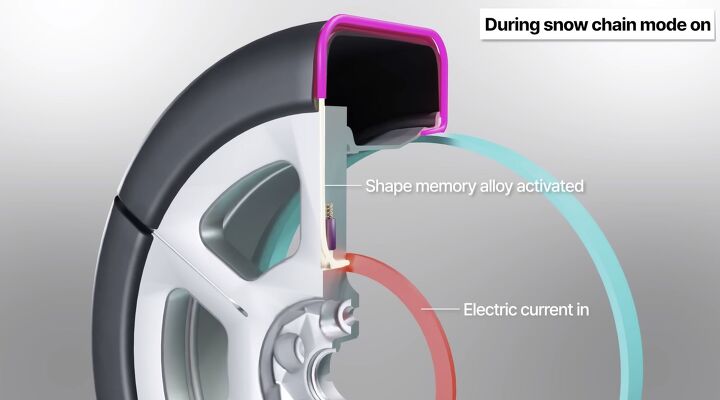
Hyundai Motor Group have introduced a novel snow chain that’s integrated directly into the tire. The design allows drivers to deploy the system at the push of a button, allowing drivers to sidestep some of the disadvantages associated with installing snow chains.
Korean automakers Hyundai and Kia state that the technology relies on “shape memory alloy modules that are located inside the wheel and tire.” While the metallurgy involved can vary, the general premise involves creating an alloy that takes on a fixed shape at certain temperatures and becomes flexible at others. You’ve actually probably encountered shape memory alloys before, as they’re fairly common in medical, dental, and even plumbing applications.
However, advancements in the technology have resulted in companies running an electrical current through the material as a possible alternative to springs and hydraulics. This is also how Hyundai plans on deploying its integrated snow chains, which are actually more like paddles wrapped around grooves that have been cut into the tire.
From Hyundai Motor Group:
The snow chain-integrated tire technology consists of a wheel and tire assembly that feature radial grooves at regular intervals, like a pizza, with modules made of shape memory alloy inserted into these channels.
This technology takes advantage of the shape memory alloy’s ability to return to its original shape when an electric current is applied. During normal driving, the shape memory alloy located inside the wheel is compressed into the shape of the letter ‘L’ and does not contact the road surface. When the driver activates the function, an electric current is applied, causing the shape memory alloy to revert to its original profile; the material forms a ‘J’ shape, pushing the module out of the tire to make contact with the surface, improving grip, stability and safety on snowy roads.
Keeping snow chains on hand is never a bad idea. But actually installing them onto the vehicle is often a miserable task that forces you to scramble on your hands and knees in freezing weather. While certain chains will be quicker to fit than others, most require making adjustments and all of them are likely to result in you becoming colder and wetter than desired.

You’ll also find yourself having to take them off sooner than you’d like, as they’re only suited to clawing through slippery surfaces at low speeds. Snow chains are a liability on clean pavement and are prone toward breaking at speeds above 30 mph. Prolonged use (even at extremely low speeds) will also gradually chew up your tires and mar the pavement.
Hyundai’s concept sidesteps a lot of those issues by having metal paddles that can be deployed or retracted with the simple push of a button. Though we imagine the real trick will be finding a way of having this equipped to vehicles that won’t make tire changes cost a fortune. The shape memory alloy wires need to be embedded into the rubber. But they also have to interact with the vehicle’s electrical system, likely making tire swapping a little tougher than normal. Considering how obnoxiously prevalent tire pressure sensor faults become after vehicles begin to mature, integrated snow chains sound like they could eventually become a headache.
Tire pressure sensors are useful every time you’re driving, making it easier to rationalize the extra maintenance. But snow chains are something most drivers probably won’t need and those that do will only use once or twice per year. Despite being an intriguing concept, reminiscent of the kind of thing you’d see on the Batmobile or whatever James Bond is driving, it might be a tough sell to everyday consumers.
Hyundai says it’s working on that. Tire wear is supposed to be comparable to what’s available today and owners should be able to easily recognize when it’s time to buy some new rubber without special training. Beyond installation, it looks like the company is striving to make the experience identical to owning a set of regular all-season rounds.

“This innovation, which will hopefully be introduced on Hyundai and Kia vehicles someday, reflects our commitment to turning advanced technologies into real-world solutions that benefit customers,” said Joon Mo Park, Head of Hyundai’s Advanced Chassis Development Team. “We will continue to develop technologies that enhance safety and convenience of our vehicles and bring value to our customers.”
The technology is patent-pending in both South Korea and the United States. But Hyundai and Kia say they’d like to field the units on production vehicles once there’s been more development time, some durability testing and the necessary regulatory approvals.
The tires may even be paired to the Uni Wheel concept the Korean automaker presented last month that’s supposed to do away with traditional constant-velocity joints by installing dynamic gear sets inside of the wheel hub. While the mechanical advantages to this seem fairly limited, the concept is supposed to result in a cleaner floorplan that allows for extra cabin space. But I’ve got questions about the utility of having heavy gear sets adding to the vehicle’s un-sprung mass and exactly how Hyundai intends on keeping them lubricated.
It’s another interesting idea from an automaker bent on innovation. But it also sounds too complicated to be a success. Hyundai’s retractable snow chain idea is significantly more appealing and something we’d love to see turned into a commercially viable product someday.
[Images: Hyundai]
Become a TTAC insider. Get the latest news, features, TTAC takes, and everything else that gets to the truth about cars first by subscribing to our newsletter.

